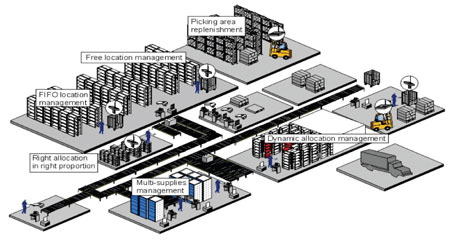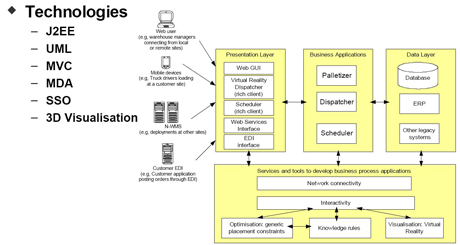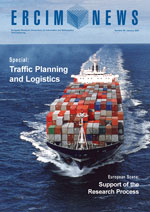by Francois Fages and Abder Aggoun
Net-WMS - Towards integrating Virtual Reality and optimisation techniques in a new generation of networked businesses in Warehouse Management Systems (WMS) under constraints - is a new project managed by ERCIM, developing interactive optimisation tools and prototype software that will form the basis for a new generation of networked services for WMS.
Net-WMS will handle networked communication and co-operation processes through the integration of decision-making technologies, generic 2D, 3D and higher-dimensional placement constraint solvers, visualisation and interaction with the solvers in virtual reality, packing models and knowledge modelling with business rules. Its scientific outcome will be relevant to the whole domain of combinatorial optimisation and will have direct technological impact on supply chain management at both the WMS and Transportation Management Software (TMS) levels, especially in the areas of packing, vehicle loading, space management, planning and scheduling, inventory control and packed item visualisation.

Prototype Applications
Net-WMS prototype applications will be operational in an environment of networked warehouses, thanks to their interoperability and to the user-friendly interface designed for plant-level technicians. They will include innovative tools and plug-ins including:
- a packing modeller of items based on optimisation techniques and interactions in virtual reality
- a palletizer tool using optimisation techniques
- a dispatcher, which includes the virtualisation of a truckload
- a set of interfaces enabling communications between several planning components across a network.
The project goals are threefold. First, from a scientific standpoint, significant advances are expected on:
-
the algorithmic treatment of global placement constraints for objects of higher dimensions including space and time
-
the expression of constraint optimisation problems with a language of business rules
-
the control of an optimisation tool with interactions in virtual reality.
Second, on the technological side, the project will pave the way for next-generation WMS software by applying innovative technology to enhance operations in industrial warehouse environments. This includes:
-
a set of Java Platform, Enterprise Edition (J2EE) interfaces for interoperability and mobile services, enabling communications between planning components across a network
-
a mobility interface, allowing remote users (eg truck drivers) to report planning changes
-
new interactive modules combining constraint programming, rule programming and virtual reality, in support of modelling, simulation and optimisation of the packing process
-
a set of high-level modelling libraries for the constraint programming system Choco
-
extensions to rule programming tools such as constraint handling rules (CHR) and Drools.
Third, on the commercial side, Net-WMS aims at improving European competitiveness in the area of warehouse management by significantly reducing costs related to packing, manpower and transportation.

Net-WMS is a Specific Targeted Research Project co-funded by the European Commission's ICT for Enterprise Networking D5 Unit. IST in FP6 focuses on future-generation technology in which computers and networks will be integrated into the everyday environment, allowing easy access to a multitude of applications and services through user-friendly human interfaces. Net-WMS places this vision at the heart of its activities and as such contributes to the Ambient Intelligence (AITPL) European cluster.
Net-WMS commenced on 1 September, 2006 and will be active for three years. The consortium has a combined expertise and field knowledge that guarantee the project will reach its objectives. It is composed of ten members representing both academia and industry including the ERCIM members INRIA and SICS.
Link:
http://net-wms.ercim.org/
Please contact:
François Fages
INRIA, France (scientific coordinator)
Tel: +33 1 39 63 57 09
E-mail: francois.fages![]() inria.fr
inria.fr
Abder Aggoun
KLS OPTIM, France
(technical coordinator)
Tel: +33 1 60 14 66 85
E-mail: abder.aggoun![]() klsoptim.com
klsoptim.com
Philippe Rohou
ERCIM office
(administrative contact)
E-mail : philippe.rohou![]() ercim.org
ercim.org
Tel: +33 4 97 15 53 06










